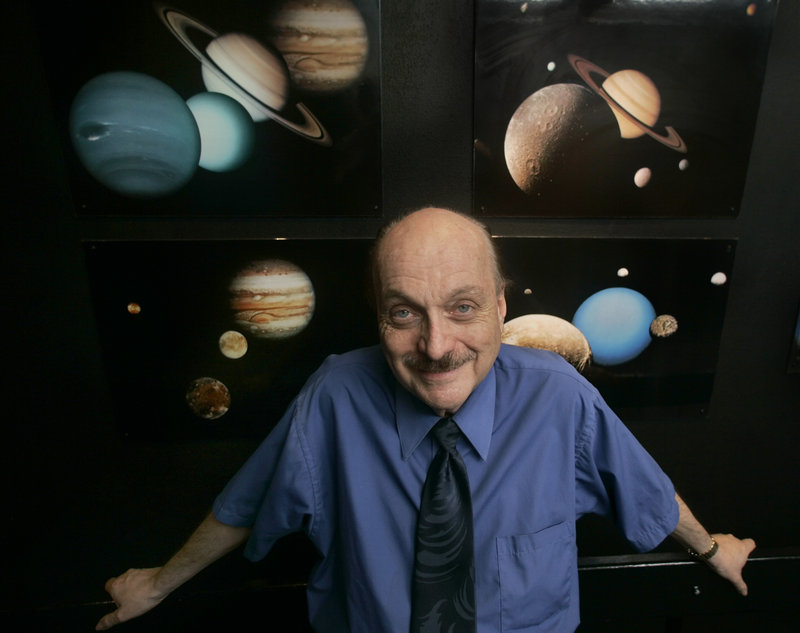Jack Horkheimer, a playwright turned amateur astronomer who inspired millions of people to look a little closer at the nighttime sky with his pioneering planetarium shows and long-running public television show, “Jack Horkheimer: Star Gazer,” died Aug. 20 in Miami of a respiratory ailment. He was 72.
Horkheimer was perhaps most widely known as the ever-enthusiastic, slightly bug-eyed host of his television show, originally called “Jack Horkheimer: Star Hustler,” which ran for more than 30 years and offered naked-eye astronomy lessons in digestible doses.
He was still writing and hosting the weekly five-minute segment at the time of his death; prerecorded episodes scheduled to run through Sept. 5 are available on his Web site. Using plain language, cheesy animation and a trippy-spacey synthesized soundtrack, he deciphered constellations and explained everything from solar eclipses to the winter solstice.
“Greetings, greetings, fellow stargazers,” was his signature introduction, delivered with caffeinated eagerness.
Often pictured perched on the cartoon rings of Saturn, Horkheimer also recounted age-old myths about the celestial realm. The constellation known as Lepus the hare, he reminded viewers in a 1986 episode, has been seen in the West as a “heavenly rabbit, huddled and cringing in fear in the grass beneath the feet of Orion the Hunter.” Or, according to Chinese tradition, it is a rest stop in the sky — in Horkheimer’s terms, a “heavenly outhouse in the sweet bye and bye.”
“If you’ve never heard this stuff before,” he told Astronomy magazine in 2006, “it blows your little blue booties off because it’s fun, fun, fun.”
Millions of people each week watched the show, which aired on PBS and on the United States Information Agency’s Worldnet. Horkheimer also organized stargazing parties and was a frequent commentator in the national media on comets, eclipses and other astronomical events. He called himself a science dramatist, not an astronomer, and was clear that his interest in outer space lay not so much in science as in more sweeping existential questions.
Horkheimer served for 35 years as the director of the Space Transit Planetarium at the Miami Science Museum. He turned presentations there from academic lessons into whiz-bang shows that used music, metaphor and animation to explore the night sky and inspire curiosity about the heavens.
Tinkering with lasers and state-of-the-art projectors, he created images of floating, three-dimensional planets and other special effects. Among his award-winning presentations were “Child of the Universe,” starring talk show host Sally Jessy Raphael as the voice of the solar system.
Horkheimer’s early multimedia shows captured the imagination of young children and science-averse grown-ups alike, attracting wide audiences that helped make the planetarium a profit center for the Miami Science Museum. Planetarium directors around the world began to imitate his style.
Jack Horkheimer was born Foley Arthur Horkheimer in Randolph, Wis., on June 11, 1938. He had a congenital degenerative lung disease that went undiagnosed until he was 18, leaving him with chronic pain and trips to the hospital.
His father, a wealthy publisher who served as mayor of Randolph, “wanted me to be an athlete and, because of my lungs, I could never hack it,” Horkheimer told the Miami Herald in 1982. “I was always a failure in my father’s eyes.”
Horkheimer went to a Jesuit prep school, where he learned to play the organ, performing under the stage name “Horky.” He later took the name Jack Foley and, eventually, Jack Horkheimer.In early shows, Horkheimer was terribly professorial.
When the show went national in 1985, the executive producer urged Horkheimer to lighten up. Thus was born a more elated, more exaggerated version of Jack Horkheimer, Star Gazer, who exhorted viewers to “keep looking up!”
Send questions/comments to the editors.



Success. Please wait for the page to reload. If the page does not reload within 5 seconds, please refresh the page.
Enter your email and password to access comments.
Hi, to comment on stories you must . This profile is in addition to your subscription and website login.
Already have a commenting profile? .
Invalid username/password.
Please check your email to confirm and complete your registration.
Only subscribers are eligible to post comments. Please subscribe or login first for digital access. Here’s why.
Use the form below to reset your password. When you've submitted your account email, we will send an email with a reset code.